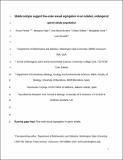Stable isotopes suggest fine-scale sexual segregation in an isolated, endangered sperm whale population
Abstract
Sexual segregation is common among marine mammals, leading to intraspecific differences in diet, diving behaviour, home range size and even latitudinal distribution and migratory patterns. Sperm whales Physeter macrocephalus present one of the most extreme examples of sexual dimorphism both in size and social structure, with males and females segregating at different latitudes across most of their range, but the underlying ecological drivers remain unclear. Studying fine-scale dietary and habitat differences where the sexes occur in sympatry could therefore provide insights into the mechanisms underpinning their large-scale segregation. In this study, we analysed the carbon and nitrogen stable isotope values in the skin of males and females from an isolated, endangered population inhabiting the Mediterranean Sea, sampled in a region where the sexes occur and feed regularly in the summer months but show subtle differences in habitat preference. We found marked differences in both carbon and nitrogen isotopic values between the sexes, indicating that they could be targeting prey items in different trophic levels and habitats. Combined with the evidence from habitat modelling studies, our results suggest that female and male sperm whales segregate even in the latitudinally restricted Mediterranean population, at a much smaller scale. This sympatric, fine-scale sexual segregation suggests that reduction of competition may have been a key factor in the evolution of the social structure and large-scale latitudinal segregation of this species.
Citation
Pirotta , E , Vighi , M , Brotons , J M , Dillane , E , Cerdà , M & Rendell , L 2020 , ' Stable isotopes suggest fine-scale sexual segregation in an isolated, endangered sperm whale population ' , Marine Ecology Progress Series , vol. 654 , pp. 209-218 . https://doi.org/10.3354/meps13502
Publication
Marine Ecology Progress Series
Status
Peer reviewed
ISSN
0171-8630Type
Journal article
Description
Funding: This work was supported by the National Geographic Society [grant number EC-53116R-18].Collections
Items in the St Andrews Research Repository are protected by copyright, with all rights reserved, unless otherwise indicated.

